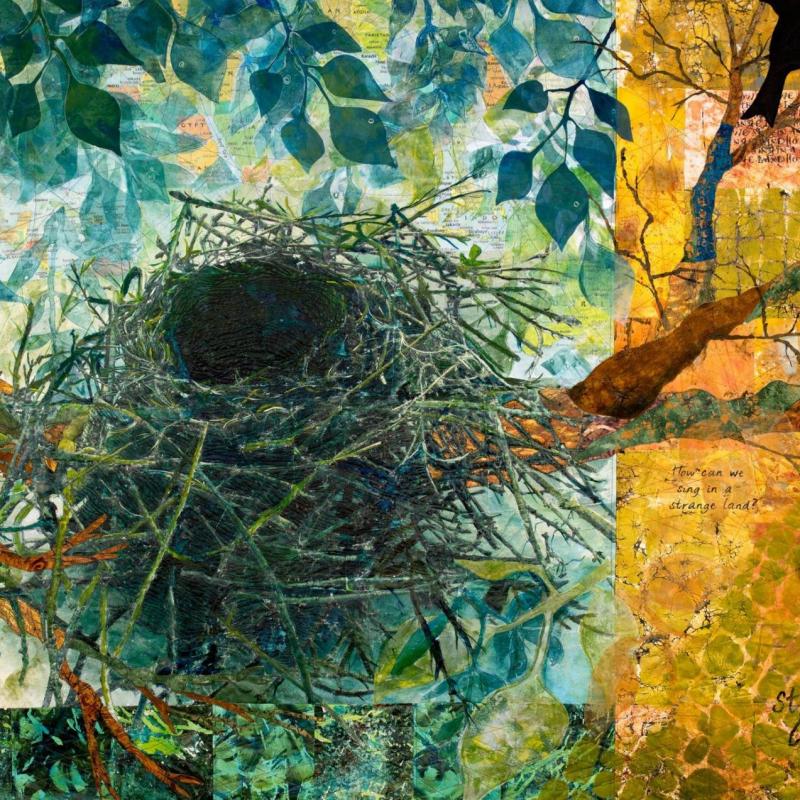Reprinted from Art Quilt Collector #4
When Del Thomas of Placentia, California, purchased her first quilt at a 1985 guild auction, she had no plans to create a contemporary quilt collection. “I bought a small quilt by Judy Mathieson because I loved it,” Del said. “Maybe a year later, I bought another quilt and then another. They say that two’s a pair, three’s a collection.”
The Thomas Contemporary Quilt Collection has grown to more than 300 quilts, including more than thirty quilts by Ruth B. McDowell and more than a hundred 12-inch x 12-inch quilts purchased from Studio Art Quilt Associates’ (SAQA) annual auctions, online auctions by various quilt-related groups, and 12 given to her by the International Twelve by Twelve group.
While many of the quilts are by well- known artists, Del said her collecting is not about acquiring work only by big-name artists. She has clear criteria for her purchases.
“First and most important, a quilt must speak to me,” Del said. “I don’t care who made it or the technique used. It just has to speak to my heart. I ask, ‘Could I be happy with this quilt on my wall if it were the only quilt I could own?’” The answer must be a resounding, “Yes!” Several of the quilts in the collection were made by artists who had never sold a piece until Del purchased one. “I look at everybody’s work, whether the artist never made a quilt before or has sixty years of experience.”
What speaks to Del’s heart has changed over time. While she said she’s not attracted to “real far-out” pieces, her purchases have become bolder. “When I first started, I bought more quilts that leaned toward traditional,” she said.
“I have always been more attracted to realism; to something I recognize, like trees or birds, though as the years have gone by, I’ve come to appreciate pieces that are more abstract.” Del doesn’t buy every quilt that speaks to her. That’s where her second criterion comes in.
“I have to ask if I can afford it,” she said. “I don’t have unlimited funds.” She strives to get the most for her money.
“I appreciate artists who include prices on their websites,” Del said. “When they don’t list prices, it’s so time-consuming to get them from the artists. Some seem reluctant to give prices and I don’t want to bargain.”
She finds some of the best opportunities to purchase quilts through online auctions, such as the annual SAQA auction and similar auctions held as fundraisers for organizations, museums, and guilds. Del has one final criterion when buying quilt art: Can she store and transport the quilts easily?
“I don’t buy quilts I have to store or ship in crates like paintings,” she said. “That means no quilts on stretchers.” She also avoids those that have a lot of small items sewn or glued to the surface because they are difficult or impossible to roll without damaging the embellishments. “I have one quilt with shells on it,” she said. “One has been broken. Also, as much as I might like
a quilt, I can’t have anything that has to hang on the wall all the time.”
She stores large quilts in a stack on a bed. Others, she rolls onto what she calls “stuffies” — long tubes about the size of pool noodles that she makes from batting scraps covered with fabric.
Finding quilts to buy
When Del began collecting art quilts, she located many by searching magazines. Now she uses the Internet, but she finds that seeing art quilts at shows is still the best way to find additions to her collection. She especially likes to attend large shows because they have more variety. “When I have time, I browse artists’ websites and blogs,” she said. And she likes sites where work by multiple artists is featured.
Del rotates displays of the quilts in her home and is generous in sharing her collection. She loans quilts to museums, does presentations at guild meetings, and posts images and comments on her blog (www.delquilts.blogspot.com) most Sundays.
Museums and guilds in southern California, where she has lived since 1957, have especially benefited from her willingness to share. “Right now, I have a selection of small 12 x12 quilts hanging in my family room and a large Marianne Burr in the hall,” Del said. “I always have a quilt hanging in my bedroom, and my friends enjoy having quilts in their homes once in a while.”
She sponsors the large gallery at the Visions Art Gallery in San Diego named in her honor. The Museum has shown several exhibits of quilts from the Thomas Contemporary Quilt Collection during its nine years of existence.
Pieces from the collection have been displayed in museums and galleries in Japan and across the United States. Del sometimes travels with the quilts, lecturing and leading exhibition and gallery tours.
Del Thomas as quilt artist
Del is a quilt artist as well as a collector. She began quilting at age seven, making doll quilts with her grandmother.
“I used to go with my grandmother to the Grange,” Del said. “All the ladies would come and quilt around the frame. And I would pick up things that were dropped and thread needles.”
During the late 1970s, her experiments in quilt- making led Del into quilts as art. Her work has been exhibited and published in several books and magazines. She enjoys trying new techniques and prefers to work with commercial cotton fabric, which she pieces and quilts by machine. Before she began collecting quilts, Del helped organize a local guild, which exposed her to a variety of quilts and introduced her to a diverse group of quiltmakers. She now belongs to five local quilt guilds. “I keep up with what’s going on locally,” Del said. “I like to support the guilds because I think they are import- ant in women’s lives.”
Del would like to see traditional quilters and quilt artists talk to each other more. She has presented several programs that show the relationships between the two genres of quiltmaking but hasn’t found many receptive audiences. “I’m a docent at the Visions Art Museum, where people come in and see contemporary quilts for the first time. They can’t believe this art exists. Very, very slowly, I’m seeing more interest in quilts as art among non-quilters. Fiber artists are working hard to get their work into general art shows so more people will see them. That can take a lot of creativity,” she said, remembering a conversation with one artist who displayed her early work at a plumbing-supply store. Others are showing their work in restaurants, coffee shops, banks — any place that will give them space and guarantee that the art is secure.
A glimpse at the collection
With more than 200 quilts, it’s impossible for Del to talk about each one. Several of the pieces in her collection are described here.

Middlesex Fells – Late Fall, 1996, by Ruth B. McDowell welcomes viewers down a forest path that leads into the blazing color of autumn trees made from commercial plaid fabrics. By positioning monochromatic tree trunks in the middle ground, McDowell defines a scenic panorama.

Jane Sassaman’s Rose Garden, 2002, gives a close-up view into natural forms. Inspired by the fairy tale Beauty and the Beast, Sassaman translates the oppositions of the narrative into graphic roses and thorns. She uses contrast to create a sense of dimensionality in intertwining stalks.

Del owns multiple pieces by Elizabeth Barton, including Chimney Pots, 2005. The images in her quilts are made from her screen-printed and hand-painted fabrics, creating a study of space and depth. Barton says of her cityscapes, “I wish to explore the beauty of everyday environments...to create a sense of place but also reveal the dynamic bones of the scene.”

Sylvia Einstein’s Minstrel, 2004, explores what Einstein calls a “dialogue with the material.” She takes advantage of the serendipity that results from fragmenting large-scale commercial prints, letting their patterns suggest the design in a balancing act.

Coyote Fence, 2001, by Susan Else, evokes boundaries, a recurrent theme in her fiber sculptures. Else says of her art, “I treat cloth not as a flat surface but as a flexible skin for three-dimensional objects. I use cloth to create an alternate universe, and the resulting work is full of contradictions. It is whimsical, edgy, mundane, surreal, and engaging, all at once.”
Many of these same adjectives could be used to describe Del’s approach to collecting art quilts over four decades. She continues to search for the next piece that will speak to her heart. Even in short blog posts, her enthusiasm for artists and styles new to her is contagious. Add a large dose of generosity in sharing her finds, and you won’t wonder that Del Thomas is a moving force in the world of contemporary quilts.
Updated from SAQA Journal, Spring 2013


